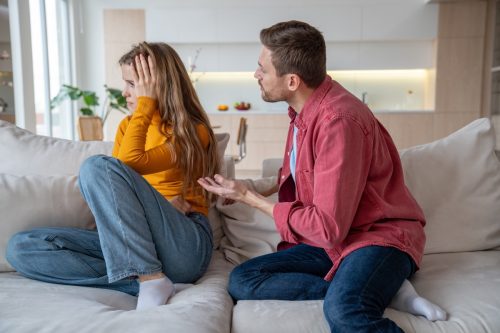How to Date Every Attachment Style

If you know a bit about psychology, you likely understand how integral your childhood is to your relationships in later life. One component of this is your attachment style, which researchers first examined in a 1969 experiment called the Strange Situation led by psychologist Mary Ainsworth, PhD. Ainsworth’s attachment theory suggests that our caregivers in early childhood directly affect our personalities and connections—including romantic ones—meaning you’ll want to understand how to date each attachment style you encounter.
“Attachment styles are formed early in our lives and play a significant role in the way in which we connect (or attach) to others throughout the rest of our lives,” says Beth Ribarksy, PhD, professor of interpersonal communication and director of the School of Communication and Media at University of Illinois Springfield. “Most researchers argue that attachment styles are usually dictated by one year of age, and for most people, the same attachment style persists throughout their entire lifetime.”
Read on to find out which attachment styles you and your partner may have, and what that means for your relationship.
RELATED: The 5 Love Languages and How They Can Help You Communicate.
What are the different attachment styles?

Secure
This attachment style is accurately named, as it applies to individuals who are secure in their relationships.
“Individuals with a secure attachment style tend to be ‘rocks’ in a relationship. They are generally self-aware, emotionally available, confident in their relationship abilities, and grounded, in addition to having high emotional intelligence,” explains clinical psychologist Carla Marie Manly, PhD, author of The Joy of Imperfect Love. “The securely attached person is able to be vulnerable and intimately connected.”
Ribarsky notes that these people also tend to have a positive view of themselves and others and are comfortable on their own or with others.
Key Traits of Secure Attachment
- Emotionally available
- Honest
- Compassionate
- Reliable
Avoidant

Also called dismissive-avoidant, this style is defined by difficulty attaching to others. According to Ribarsky, those with this attachment style tend to keep people at arm’s length.
“They never want to depend on others, often do not seek social support or validation, and often can seem distant in all their relationships because they ultimately do not believe they need anyone to feel complete,” Ribarsky says.
She notes that avoidant attachment may cause someone to withdraw from the relationship—especially if they feel someone is getting too close or dependent—and they may actually suppress emotions to avoid stronger attachment.
They also have “strong self-esteem” and an independent streak, Manly says. However, because of this “hyper-independence and strong defense mechanisms,” she cautions that it can be harder to connect on an intimate level.
Key Traits of Avoidant Attachment
- Sense of superiority
- Disconnected
- Independent
- Defensive
RELATED: 12 Best Outdoor Date Ideas in 2024.
Anxious
Anxious attachment style, sometimes called preoccupied, is when someone is fearful or nervous of being left.
“This individual often has a negative view of self and a positive view of others,” Ribarsky says. In relationships, they’re often perceived as “clingy.”
“They often need reassurance that the other person still cares and will continue to be there,” she continues. “When something goes wrong, they are quick to blame themselves and will often overthink even the simplest of things, thinking the worst-case scenario.”
This is especially true if a situation or routine deviates from what they’re used to.
“For example, if their partner doesn’t text them ‘good night,’ as they usually do, in [the anxious partner’s] brain, it is because their partner is cheating or because they have somehow made their partner mad,” Ribarsky explains.
Key Traits of Anxious Attachment
- Fear of rejection
- Low self-esteem
- Easily upset
- Jealous
Disorganized

The fourth and final attachment style is disorganized, which is often also called anxious-avoidant or fearful-avoidant. (It was not one of Ainsworth’s three initial designations, but was identified in subsequent research published in 1990.)
“This individual often oscillates between feeling anxious about their relationships and wanting to keep themselves safe by keeping people at bay,” Ribarsky shares. “They often have a negative view of self and a negative view of others.”
This can lead to confusion in relationships, and as Manly points out, these folks can be unpredictable and make you feel like you’re “walking on eggshells.”
“Individuals with this attachment style often want a relationship but are unconsciously very fearful of being close. As a result, a tug-of-war dynamic keeps the relationship from being stable, safe, and connected,” she says. “Those with a fearful-avoidant style often have low self-esteem and can sometimes have little respect for their partners.”
Key Traits of Disorganized Attachment
- Fear of getting hurt
- Inconsistency
- Signs of both anxious and avoidant attachment styles
- Low self-esteem
RELATED: 7 Words of Affirmation to Make Your Partner Feel Loved.
How do you date each attachment style?

Because attachment styles are so intertwined with relationships, they can directly affect the romantic variety. So, depending on which style you’re dating, keep a few things in mind.
Dating a Partner With Secure Attachment
People with secure attachment are likely to be the most adaptable in relationships.
“Dating a person with a secure attachment style tends to be fairly easy,” Manly shares. “Those in this group are often confident and emotionally intelligent, so the dating experience tends to be authentic and communicative. There is little—if any—game-playing with a securely attached individual.”
Still, keep in mind that you need to strike a balance between caring for them and letting them do their own thing.
“Don’t be offended if they don’t want you to join them at the gym, but they’ll be happy to have dinner together afterward,” Ribarsky says.
Dating a Partner With Avoidant Attachment

Dating an avoidant partner can be more challenging and can change depending on your own attachment style. According to Manly, there can be issues when a securely attached person is in a relationship with an avoidant partner. The securely attached partner will likely struggle with the level of disconnect.
Ribarsky notes that people with avoidant attachment will want both physical and emotional space in a relationship.
“They will often want to go do things on their own, and while this might seem strange or even offensive to others, it is more so a time to focus on themselves,” Ribarsky explains.
You may want to limit the amount that you reach out—and understand they may not respond right away or within a timeframe that you’re used to. Doubling down with more messages is likely to push them away as well, Ribarsky warns.
RELATED: 8 “Small But Toxic” Things to Stop Saying to Your Partner, According to Therapists.
Dating a Partner With Anxious Attachment
A partner with anxious attachment will likely need reassurance in a relationship, largely due to their fear of being abandoned, Ribarsky says.
“Consistency is key with the anxious individual, so what might seem like an insignificant routine to you might mean the world to them, such as texting good morning or kissing good night,” she says. “When they are seeming especially anxious, saying something like, ‘Hey, I’m here for you. I’m not going anywhere,’ can remind the anxious person that they are safe with the other person.”
Keep in mind that these partners may seem “clingy,” but it’s usually not in an attempt to exert control. Instead, it’s that reassurance factor.
Depending on your attachment style, you might need a different approach. When two anxious partners enter a relationship, it can work, but Manly notes that trust issues and “emotional dysregulation” may become roadblocks.
“In some cases, the connection can feel safe and strong if the partners don’t trigger each other’s deepest fears,” she shares. “In such cases, as ‘safe’ as partners might feel, unaddressed wounds often silently fester and manifest as anxiety and stress.
In this case, these two individuals may also work well together in developing “strong, loving, mutually secure attachment styles given their ‘I get you, and you get me’ bond,” Manly says.
However, an anxiously attached person and an avoidant one aren’t likely to fare well.
“The self-isolated ways of the dismissive-avoidant partner will constantly leave the anxiously attached partner feeling unloved, unsafe, and unwanted,” Manly cautions. “Of course, if both people are working on their inner issues, positive changes can occur, but this tends to be a difficult match!”
Dating a Partner With Disorganized Attachment

Dating someone with disorganized attachment can be particularly difficult, Ribarsky says.
“But, it is important to remember that they are not choosing to feel this way—it is the way their brain is wired. Ultimately, patience is key,” she stresses. “There will be times when it feels like they are pushing you away, but know it is because they are feeling unsafe and ultimately are seeking reassurance.”
Manly also warns that it can be difficult if both partners have disorganized/fearful-avoidant attachment styles.
“Due to the often-combustible, fearful nature of the fearful-avoidant type, explosions can occur when two fearful-avoidant types encounter friction; this setup will tend to worsen both partner’s wounds,” she says.
Again, if you or your partner have this attachment style, the key is working on yourself.
“When two fearful-avoidant types are both engaged in self-work, mindful attention to each partner’s inner wounds can be grounds for healing and intimate connection,” Manly says.
RELATED: 20 Date Night Movies You and Your Partner Will Both Love.
How do attachment styles develop?

These attachment styles are formed during early childhood, with different bonds developing depending on how well their caregivers (typically parents) tend to their needs.
Secure: Those with secure attachment had their needs met as infants and were confident that their caregiver would respond to their cries. They trusted their caregiver to console them as well, and as they get older, they trust others in relationships as well, Ribarsky notes.
Avoidant: People with an avoidant attachment style had a caregiver who “rarely” appeared when they cried. This leads them to believe that crying won’t get them what they need, so they develop their own coping skills and tend to have a positive sense of self and a negative sense of others. (In Ainsworth’s experiments, these kids left their mother’s side to play on their own, and they were unaffected when their mother left or returned to the room.)
Anxious: On the other end of the spectrum, people with anxious attachment had inconsistent caregivers, with a parent sometimes responding to their cries and sometimes not. As a result, these people developed a fear of being left, as they weren’t sure if their caregiver would return. According to Ribarsky, an avoidant attachment style isn’t unusual for children of divorce, or of parents with substance abuse disorders.
Disorganized: People form a disorganized attachment style when caregivers are inconsistent with how they respond. As children, they didn’t know whether their caregiver would react chaotically in stressful situations, leaving them feeling “disorganized” and potentially unsafe in relationships. According to Ribarsky, this style sometimes develops due to trauma.
RELATED: 10 Dating Red Flags You Should Never Ignore, Therapists Warn.
Wrapping Up

No matter which attachment style you and your partner have, Manly flags desire and commitment to evolving as the key to any romantic bond.
“A healthy relationship can be crafted when both partners are mutually invested in creating the positive changes necessary to earn a secure attachment style,” she notes.
However, if you feel like your partner’s attachment style is negative or triggering for you, it can be helpful to reflect on why you feel that way.
“In some cases, it might be that your unresolved issues are getting triggered—and are ready to be healed,” she says. “In other situations, you might be picking up that the relationship is not a good fit due to unresolved attachment issues or other challenges.”
Lastly, keep in mind that people may have variations or combinations of attachment styles. As Manly points out, your partner’s attachment style might not “fall fairly neatly into one of the four styles.”